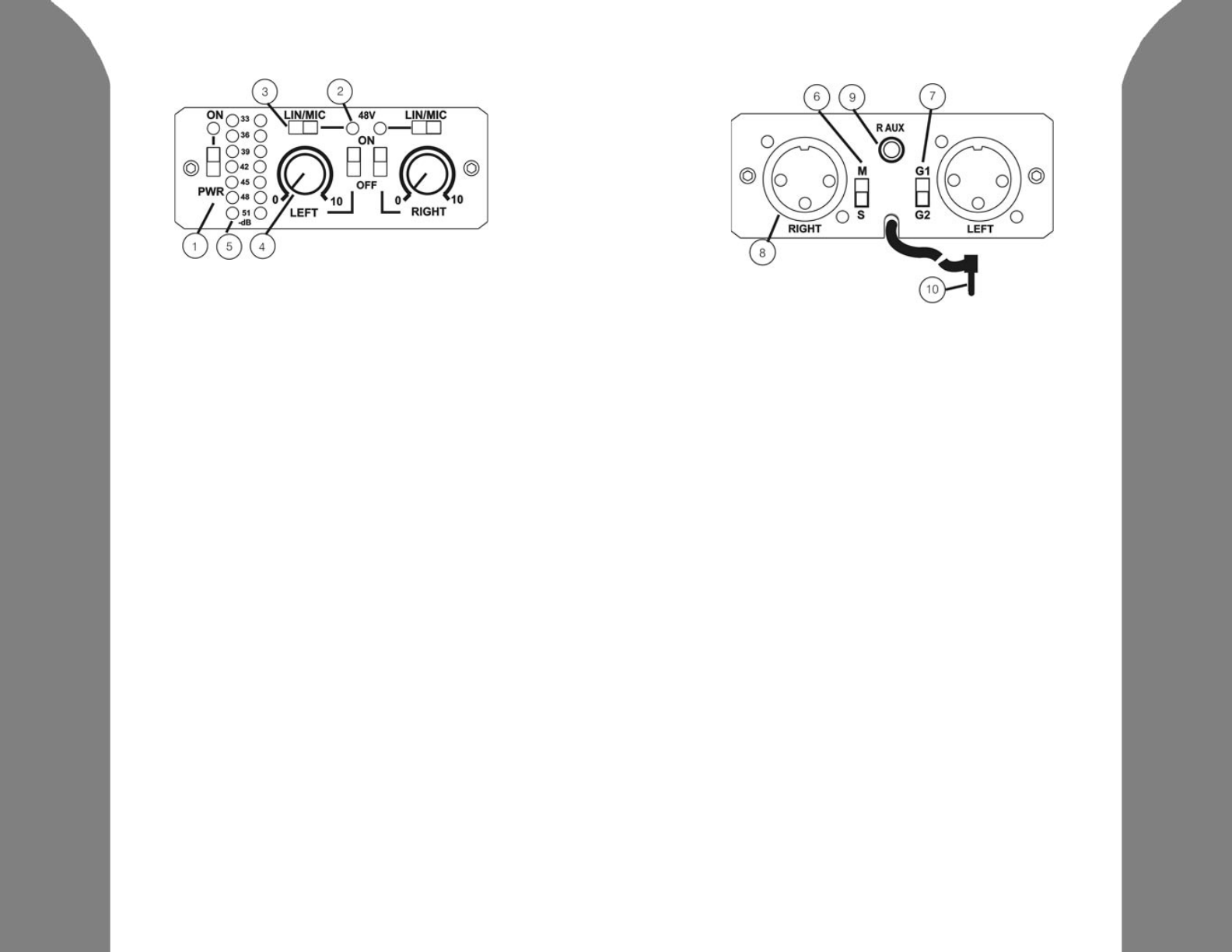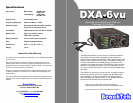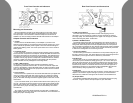
Rear Panel Controls and Connections
5.) LED Level Indicators
The meter will show the signal levels of each channel going into the
camcorder. You can use this as a guide to monitor the levels for optimum
recording quality. The ideal setting is for the signal to be as high as possible
without activating the yellow -33 dBu LED.
6.) MONO / STEREO Switch
The MONO setting mixes both channels together and sends the audio to
both the right and left channels which is ideal when only one microphone is
being used. Stereo keeps both channels separated when two microphones
are connected to the adapter for two discreet audio channels. When in MONO
mode, be sure to keep the trim control on the unused channel fully clockwise
to reduce the loading effect on the working channel.
7.) Ground Lift Switch
Set the G1/G2 ground switch on the DXA-6vu to the position that gives you
the least amount of noise. This switch allows the input and output grounds to
be isolated to prevent ground noise on some Sony camcorders.
8.) XLR Inputs
The two XLR inputs can accept balanced or unbalanced connections. To
convert the input to unbalanced, simply ground pin 1 to 3 on the XLR input
cable. We recommend the use of sensitive condenser type microphones for
the best results. Dynamic microphones usually do not have sufficient output
levels and may result in an excessive amount of hiss from the high level of
amplification necessary by the camera’s audio preamplifiers. Microphones
with a sensitivity rating of greater than -40 dBV are ideal.
9.) AUX Input
To attach audio devices with mini-jack connectors, use the AUX input on the
adapter. This sends the signal to the right input and you should therefore
disconnect any cables from the right XLR connector to avoid interference.
10.) Output Cable
The attached shielded cable terminates in a gold plated, stereo mini plug
connector. Plug this into the microphone jack on your camcorder.
©2006 BeachTek Inc.
Front Panel Controls and Indicators
Mounting and Connection
Mount the DXA-6vu securely to the tripod bushing on the under side of
your camcorder. Connect the cable from the DXA-6vu to the camcorder’s
microphone jack. The camcorder’s onboard microphone should now be
disabled. You are now ready to attach external audio devices to the adapter.
Adapter Controls and Connectors
1.) Power
Install a fresh 9 volt alkaline battery in the adapter if you wish to use
phantom power (battery is not required to pass the audio signal). Turn on the
unit to activate the phantom power supplies. The Power LED should light to
indicate good battery power. Turn off the power when not in use to conserve
battery power.
2.) Phantom Power
If your condenser microphone requires 48 volts phantom power to operate,
first connect the microphone to the adapter. Activate the PWR ON switch and
then the PH ON switch for the channel it is connected to. The LED above the
corresponding channel trim control should light to indicate that 48 volt power
is present. Do not plug dynamic microphones, unbalanced devices, wireless
receivers or feeds from mixing boards into the adapter with the phantom
power activated as it may damage the connecting device.
3.) MIC / LINE Switches
To connect a microphone to either channel of the DXA-6vu, set the
corresponding MIC/LINE switch to MIC. To connect a line level output from
a mixer to the DXA-6vu, set the MIC/LINE switch to LINE to activate a 40 dB
pad. This attenuates the signal to the proper level so that it will not overdrive
the input of your camcorder.
4.) Trim Controls
Each channel has a passive trim control that attenuates the input signal from
unity to no output. Adjust each trim control to give you a maximum reading
of -36 dBu on the level meter. The yellow LED should not activate. This will
give you the ideal recording level for the highest signal to noise ratio on most
camcorders
If your camcorder allows you to switch the Auto Gain Control (AGC) off, you
can use this option for manual control over the audio levels. Initially set the
camera gain to about 30% of maximum. You can then fine tune the camera
gain control to the proper recording level as recommended by the camera
manufacturer.
As a guide, the recording levels should be no higher than -12 dBFS (Full
Scale). Please refer to your camcorder’s user manual for more information on
setting the proper recording levels.




